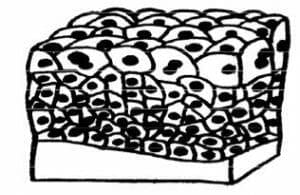Test: Epithelial Tissue - NEET MCQ
30 Questions MCQ Test Topic-wise MCQ Tests for NEET - Test: Epithelial Tissue
Which of the following mammalian tissues is associated with filteration and diffusion ?
The simple squamous epithelium lining the blood vessels is called as
Curved portion of the Henle’s loop of the nephrons are lined by
Which of the following epithelium covers the inner linings of trachea, large bronchi and helps to remove mucus ?
The adjacent epithelial cells are held together by means of
Pseudostratified non-ciliated columnar epithelial tissue is found in -
Which of the following epithelium is much thinner and more stretchable than the stratified epithelium and covers the inner surface of urinary bladder and ureter ?
Which of the following cells are specialised for sensory functions, e.g., cells of taste bud ?
Which of the following tissue is present in maximum amount, joins different tissues, forms the packing between them and helps to keep the organs in place and normal shape ?
Columnar Epithelium with micro villi or Brush Border is present in -
What type of epithelial tissue is found in the air sacs of lungs and facilitates gas exchange?
What is the primary function of the flame cells in flatworms (Phylum Platyhelminthes)?
Which of the following statements best describes the phylum Cnidaria?
Epithelial lining of bartholins duct is composed of which type of cells -
Which class of the phylum Chordata is known for having animals with a cartilaginous endoskeleton?
|
9 docs|1259 tests
|



















